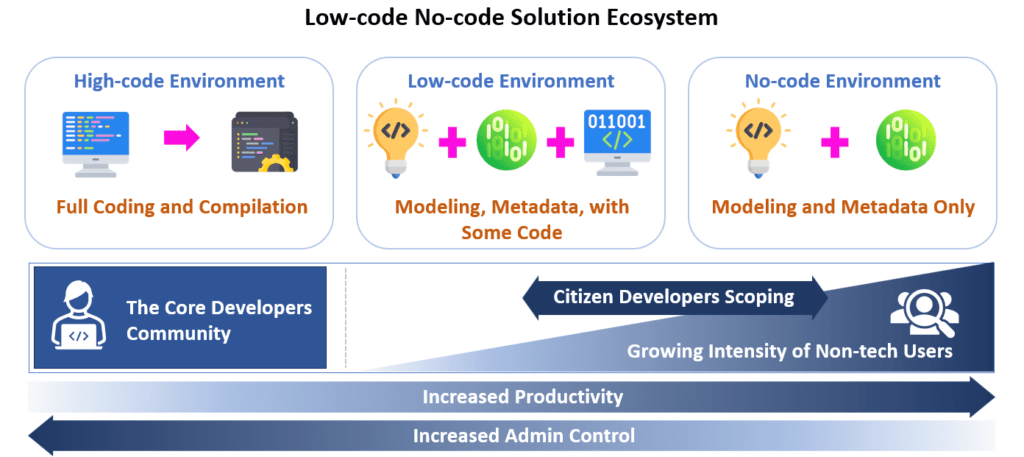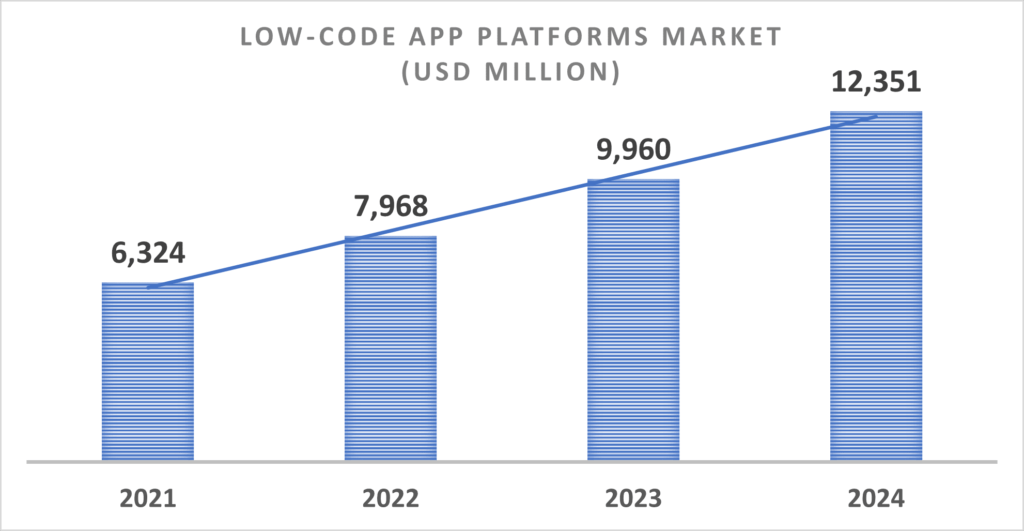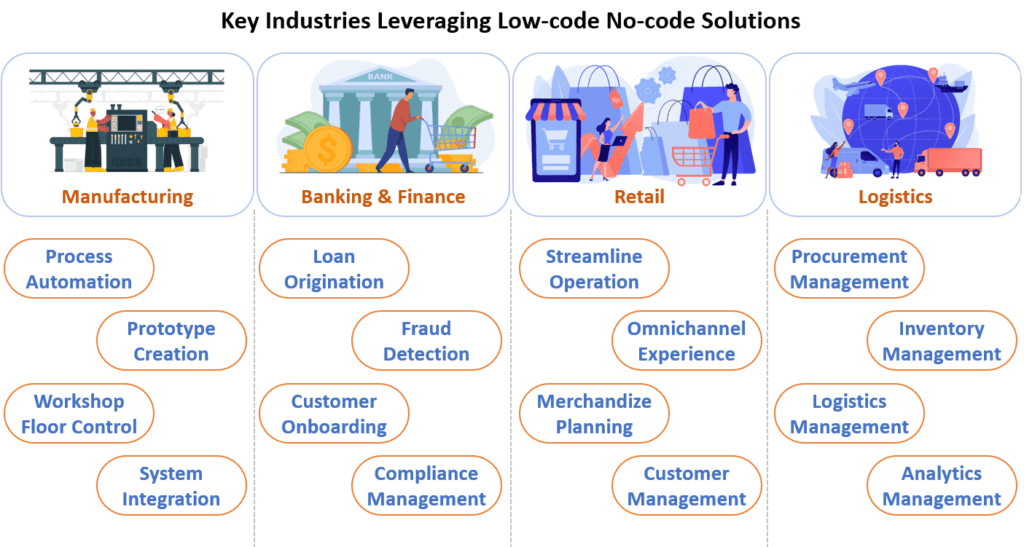
Overview:
Mastering programming code is no simple feat. It demands a deep grasp of coding languages, syntax, and their precise application for specific tasks. In days gone by, crafting code from scratch was the norm, creating applications that stood out as unique among a sea of similar counterparts. However, the relentless march of competition and the urgency to deliver applications to market swiftly have compelled developers to work against the clock.
In response, software development firms found themselves confronted with a limited set of choices: either deliver pre-made applications with minimal customization options or embark on the laborious journey of creating bespoke applications, involving an army of skilled developers and coders. Yet, a new paradigm emerged – the Low-code No-code (LCNC) development alternative, offering a swift, agile approach to satisfy a range of unique user requirements within the business landscape.
Enter the realm of LCNC solutions, introducing an intuitive, graphical interface empowering user to effortlessly drag and drop essential building blocks to construct applications tailored to their precise needs. While the front end may display sleek layouts, the back end retains a meticulously crafted codebase. The adoption of LCNC tools ultimately affords users greater flexibility and ensures timely alignment with business demands.
To embark on this transformative journey of LCNC solutions, we must first navigate the landscape of full-coding, low-coding, and no-coding, unraveling their intricacies and unique prerequisites. Without further ado, let’s dive right in.
Contents:
- Understanding the full, low, and no-coding
- How is the Low-code No-code ecosystem structured
- How Low-code No-code is driving ‘Citizen Developers’
- The potential future of Low-code No-code solutions
- Factors driving the growth of Low-code No-code solutions
- Key benefits of Low-code No-code solutions
- How key industries leverage Low-code No-code solutions
Understanding the full, low, and no-coding:
| Particulars | Full-coding | Low-coding | No-coding |
| What is this? | Full-coding, also known as traditional coding, is a method of crafting applications by meticulously writing code line by line utilizing programming languages. This approach demands a high degree of expertise and specialized skill sets from software developers | Low-code development streamlines application design and development through user-friendly graphical tools (APIs) and integrated features, minimizing the need for traditional coding. It provides a simplified development experience accessible to individuals with varying levels of technical proficiency, including semi-tech-savvy users | Low-code provides a user-friendly development experience, while no-code takes it a step further by enabling even non-tech-savvy users to create applications without the need to write any code |
| Key Benefits | Offers ultimate personalization Provides complete administrative control Enhances security with customization | Requires basic coding understanding Offers a quick turnaround time Easier to maintain | Fastest to build (in hours) Highly cost-effective Easier to maintain and update Provides increased ROI |
| Major Challenges | Can be expensive and challenging to manage and update Requires a higher level of technical skills and a larger team Takes more time to build and update | Presents limited admin control Provides partial customization options Offers only standard security mechanisms | Very limited customization availability Provides very-low admin control |
| Key Examples | Usually the full-length enterprise applications (ERPs) | Low-code development platforms (LCDPs) such as Zoho Creator (App Builder), Kissflow (Work Management Platform), Appian (Enterprise App Builder) | No-code development platforms (NCDPs) such as Bubble (App Builder), Webflow (Website Builder), Airtable (Database Creator) |
Low-code development platforms (LCDPs) and no-code development platforms (NCDPs) represent modular approaches to application development. They encompass model-driven design, automatic code generation, and visual programming, enabling end users to craft business-specific applications tailored to their needs, regardless of their coding proficiency. Furthermore, these platforms elevate the quality of end applications, bringing them on par with those crafted by seasoned developers.
How is the Low-code No-code ecosystem structured:

How Low-code No-code is driving ‘Citizen Developers’:
Having subject matter experts is crucial for designing and creating applications, but in today’s fast-paced, cost-competitive environment, relying solely on them can add extra costs to each project. To mitigate this, the concept of ‘citizen developers’ has emerged.
Citizen developers are domain specialists who have worked within the organization’s field for years. Often, IT teams may lack the same level of process understanding and domain knowledge required to create applications. In such scenarios, citizen developers play a vital role in developing the necessary business applications. Leveraging their extensive knowledge, these citizen developers actively participate in the app development process, using Low-code No-code (LCNC) platforms to apply the right workflows, processes, and technologies effectively. Beyond this, citizen developers help alleviate the shortage of skilled developers, lighten the workload of IT teams, and enable faster responses to customer and market demands.
The potential future of Low-code No-code solutions:
In recent years, Low-code No-code programming solutions have surged in popularity because they empower organizations to swiftly create and deploy customized applications without the need for extensive specialized programming skills. This trend is anticipated to persist in the upcoming years as low-code platforms continue to advance and offer more robust features, thus simplifying the process of custom application development for a wider array of users.
According to a report, the global low-code development technologies market is poised for a 20% growth in 2023, up from 19.6% in 2022, with a projected value of USD 26.9 billion in 2023. It is expected to remain the preferred development solution for business technologists, facilitating industry-wide customized hyper-automation workflows and rapid application delivery in the business sector through 2026.
Low-code application platforms (LCAPs) are anticipated to be the largest segment of the low-code development technology market, with a projected growth of 25%, reaching nearly USD 10 billion in 2023.

Furthermore, it is projected that by 2026, individuals outside of formal IT departments will constitute at least 80% of the user base for low-code development tools, marking a significant increase from 60% in 2021. In 2023, 41% of non-IT professionals are already engaged in customizing or developing data and application solutions, and by the conclusion of 2025, it is expected that half of all new low-code customers will originate from corporate clients outside of IT.
Low-code No-code (LCNC) platforms, in particular, are poised to play a prominent role, being utilized in over 65% of global application development projects by 2024, and they are projected to experience a remarkable growth rate of 165% every two years.
Factors driving the growth of Low-code No-code solutions:

Four primary factors are propelling the growth of low-code and no-code programming:
| 1. Growing Shortage of Skilled Programmers: A widening skills gap in rapidly evolving operational environments and use cases | 2. Hyper-automation in the Industry: Interest in hyper-automation continues to grow due to rising demands for operational optimization. LCNC solutions, often incorporating RPA and AI/ML, facilitate this process |
| 3. Adoption of Composable Enterprise Standards: Composable enterprises excel at reusing existing packaged business capabilities (PBCs) to enable agile application development and to craft customized user experiences for novel workflows | 4. The Shorter Time-to-Market: Conventional development and testing processes demand a substantial investment of both time and resources, resulting in an extended time-to-market |
Key benefits of Low-code No-code solutions:
Low-code No-code application platforms are becoming increasingly popular among enterprises due to the significant operational benefits they provide:
1. Enhanced Efficiency and Productivity
By enabling developers to build applications swiftly and effortlessly with minimal code, Low-code No-code platforms offer a substantial reduction in development time and effort, leading to enhanced team productivity.
2. Expanded Accessibility
Low-code and No-code development tools typically feature user-friendly interfaces, often employing a simple drag-and-drop mechanism. This design enhances accessibility, allowing non-technical users to participate in the development process, thereby enabling organizations to engage a broader range of stakeholders in application creation and maintenance.
3. Lowered Expenses
Low-code No-code platforms enable users to expedite application development with minimal or no direct coding involvement. This feature proves particularly advantageous for organizations, including small and mid-sized enterprises, as it translates into substantial cost savings in application development.
4. Increased Adaptability and Agility
The capabilities of Low-code No-code empower organizations to expedite application development and deployment, enabling them to respond swiftly to evolving business requirements and accelerate their digital transformation efforts. This advantage can provide organizations with a competitive edge in dynamic and fast-paced markets.
5. Improved Collaboration
Low-code No-code programming frequently incorporates built-in collaboration features, simplifying teamwork on projects. This fosters improved communication and ensures alignment among team members, all working cohesively toward shared objectives.
6. Seamless Data Integration
Establishing workflows that encompass data collection, sharing, processing, and storage streamlines data integration, rendering it simpler and more adaptable. With Low-code No-code tools, users can readily locate, comprehend, and utilize data within a given process. This capability facilitates the identification of data sources, ownership, validity, and quality throughout processes, empowering users to make more informed and confident decisions.
7. Elevated Customer Service
Maintaining applications and workflows in alignment with customer feedback enhances both the customer experience and customer loyalty. Furthermore, CX professionals can leverage Low-code No-code platforms to create tailor-made customer surveys, e-commerce solutions, customer service applications, and loyalty programs.
8. Enhanced Privacy and Security
Low-code and No-code tools provide businesses with the capability to execute development tasks that involve sensitive data or processes. By keeping these tasks in-house rather than outsourcing them to third parties, organizations can effectively reduce the potential risks associated with data breaches and cybercrime.
How key industries leverage Low-code No-code solutions:

Manufacturing:
The manufacturing industry stands to benefit significantly from the adoption of Low-code No-code solutions. These tools enable manufacturers to model a wide array of operational processes, transforming a conventional workshop into a cutting-edge smart factory. Additionally, Low-code No-code solutions play a pivotal role in unleashing the full potential of technologies like Robotic Process Automation (RPA) and Internet of Things (IoT) networks within the manufacturing landscape.
From the initial processing of raw materials to the final stages of packaging and shipping finished goods, LCNC solutions facilitate the seamless and efficient operation of manufacturing processes. This not only enhances productivity but also contributes to the optimization of resource utilization, quality control, and overall operational excellence, positioning manufacturers to thrive in the modern industrial landscape.
Case-1: Process Automation
Manufacturers can harness the power of a Low-code No-code platform to develop a customized application for automating the tracking of raw materials, spanning from suppliers to production lines. This application can seamlessly integrate IoT devices, such as sensors, to monitor inventory levels in real-time and trigger automated orders when stock reaches predefined thresholds. As a result, manual data entry errors are minimized, and production lines consistently maintain an efficient supply of materials, ensuring smooth and error-free operations.
Case-2: Prototype Creation
Manufacturers can swiftly generate prototypes for new products or processes without depending on expensive external software development teams. Instead, they can efficiently develop custom applications in-house to experiment with and validate new concepts or modify existing workflows.
Case-3: Regulatory Compliances
Low-code No-code platforms offer manufacturers valuable support in maintaining compliance with industry regulations and standards. They achieve this by automating critical processes and furnishing comprehensive audit trails, which facilitate transparent adherence to established guidelines. Simultaneously, low-code development diminishes the necessity for manual labor in ensuring compliance with these regulations and standards.
Moreover, low-code applications play a pivotal role in streamlining quality control and inspection processes within the manufacturing domain. These applications are designed to automate data capture during inspections, generate detailed reports, and promptly alert pertinent stakeholders regarding any identified issues. By amalgamating automation and data-driven insights, manufacturers can uphold rigorous quality standards and remain compliant with industry regulations efficiently.
Case-4: Customer Service Improvement
Low-code No-code platforms serve as valuable tools for manufacturers seeking to enhance their customer service offerings. They achieve this by streamlining operational processes and bolstering efficiency, ultimately enabling manufacturers to deliver products with greater speed and precision. Additionally, these platforms empower manufacturers to create tailored customer service and order-tracking applications, further improving the overall customer experience.
Case-5: System Integration
The modular nature of Low-code No-code platforms simplifies integration with various systems and applications, including ERP or CRM systems. This strategic advantage empowers manufacturers to maximize the utility of their existing technology investments and bypass the expense associated with custom integrations. Moreover, Low-code No-code applications offer the potential to enhance production scheduling within the manufacturing sector. By seamlessly integrating with enterprise systems like ERP and MRP, these applications provide real-time insights into crucial factors, such as inventory levels and production capacity, contributing to optimized and responsive production schedules.
Case-6: Shop Floor Control
Low-code No-code applications can be tailored to monitor the movement of materials, equipment, and personnel on the shop floor, delivering real-time visibility into production processes. This capability empowers managers to base their decisions on data-driven insights. Additionally, enhanced visibility into maintenance data facilitates the generation of reports and prompt notifications to pertinent stakeholders, ensuring swift resolution of any identified issues.
Banking & Finance:
Low-code No-code technology presents a compelling solution for financial institutions seeking to meet the escalating demand for digital financial services. These platforms empower institutions to expedite the development and deployment of customized applications, addressing a spectrum of requirements. Whether streamlining backend processes, enhancing the customer experience, or expeditiously launching new digital services, Low-code No-code solutions equip banking and financial institutions to maintain competitiveness in the digital age by efficiently adapting to the evolving needs of their customers.
Case-1: Loan Origination
Low-code No-code tools are instrumental in constructing loan origination systems that empower financial institutions to expedite the loan application process. This results in swift approvals facilitated by automated workflows, aligned with the company’s established processes and policies. Moreover, the capability to analyze investment policies and track cash flows over any given period, leveraging advanced reports and dashboards, streamlines the entirety of the loan decision-making process.
Case-2: Fraud Detection and Claim Management
Low-code No-code technology offers a valuable avenue for constructing fraud detection systems, aiding financial institutions in the detection and prevention of fraudulent transactions. Additionally, leveraging low-code and no-code-powered applications, institutions can establish robust databases aligned with business policies for funds and budget management. These applications effectively manage client data, maintain contract repositories, and facilitate the setting of periodic reminders for renewals and claims management, thereby enhancing overall operational efficiency.
Case-3: Customer Onboarding
Low-code No-code technology serves as a powerful tool for crafting customer onboarding systems, enabling financial institutions to swiftly and seamlessly onboard new customers. The accelerated customer onboarding and off-boarding processes facilitated by Low-code No-code automation minimize the time invested in extensive KYC procedures. Furthermore, these automation capabilities streamline data updates and reduce the occurrence of errors, enhancing the overall efficiency of the onboarding journey for both customers and institutions.
Case-4: Compliance Management
Low-code No-code technology proves instrumental in the construction of compliance management systems, facilitating financial institutions in adhering to stringent regulatory requirements. Moreover, Low-code No-code citizen development expedites the process of implementing rapid changes to meet evolving regulatory mandates within tight timeframes. The combination of swift application development and effortless updates ensures the seamless incorporation of new requirements into the operational processes, effectively averting potential obstacles and compliance issues.
Retail:
Low-code No-code development empowers retailers with the agility to swiftly create and deploy novel applications and features, positioning them at the forefront of market trends and customer expectations. Retailers can promptly experiment with fresh concepts, assess innovative functionalities, and refine their offerings based on valuable customer input. Whether the goal is to introduce a mobile application, implement personalized recommendations, or provide virtual try-on experiences, low-code development serves as the catalyst, enabling retailers to accelerate innovation. This approach results in the delivery of cutting-edge solutions that enhance customer engagement and, ultimately, foster increased sales.
Case-1: Streamlining Store Operations
Low-code No-code platforms offer retailers the capability to craft tailored applications designed to automate labor-intensive manual tasks, including inventory management, order processing, and employee scheduling. By streamlining and eliminating these cumbersome and time-consuming processes, store staff can redirect their efforts towards providing personalized and attentive service to customers, thereby enhancing the overall shopping experience.
Case-2: Optimizing Omnichannel Experiences
Low-code No-code development tools empower retailers to construct integrated applications that seamlessly merge customer data with real-time inventory information. This integration enables customers to effortlessly browse products online, verify in-store availability, and make purchases seamlessly, offering a consistent and convenient shopping experience across various channels.
Case-3: Merchandise Planning
To mitigate the inherent risks tied to inventory forecasting, sales, and promotions, retailers can harness the power of Low-code No-code solutions to gain actionable insights into their merchandise planning. These solutions empower retailers to comprehensively evaluate past, present, and future trends related to their merchandise. Consequently, they can make well-informed, personalized decisions about their product offerings and capitalize on opportunities that might have otherwise gone unnoticed.
Case-4: Customer Relationship Management
Retailers can leverage Low-code No-code platforms to construct Customer Relationship Management (CRM) systems that consolidate valuable customer data, preferences, and purchase history. This consolidation strengthens customer engagement by enabling personalized interactions and facilitating targeted marketing campaigns tailored to individual preferences and behaviors.
Case-5: Enhancing Checkout Process
Low-code No-code platforms also serve as effective tools for optimizing the checkout process, making it more streamlined, faster, and user-friendly. Simplifying the checkout experience reduces the likelihood of customers abandoning their purchases and encourages them to complete the transaction. As a result, these platforms contribute to higher conversion rates and foster a more positive and seamless customer experience.
Logistics and Supply Chains:
Low-code No-code solutions serve as invaluable assets for automating processes, elevating visibility, and enhancing productivity across the entire supply chain. Additionally, Low-code No-code tools can seamlessly integrate with legacy systems and offer partial or full automation of numerous supply chain functions. These include managing assets and contracts, monitoring goods and inventory, facilitating invoicing, and ensuring adherence to compliance requirements.
Case-1: Procurement Management
Low-code No-code platforms offer comprehensive automation for the procurement process, spanning from requisition to purchase order and through to payment. These platforms seamlessly integrate with supplier databases, automate purchase order approvals, and efficiently manage invoice processing. Furthermore, various supply chain operations, including invoicing, inventory management, product receipt and storage, order processing, despatching, and distribution, can be either fully or partially automated using Low-code No-code platforms. Additionally, these platforms expedite the integration of Application Programming Interfaces (APIs), facilitating streamlined operations and enhanced efficiency for companies.
Case-2: Inventory Management
Low-code No-code solutions offer a robust toolkit for tracking inventory levels, effectively managing stockouts, and accurately forecasting demand. These platforms seamlessly integrate with point-of-sale systems, automating the reordering process and optimizing inventory levels. This adaptability empowers businesses to construct a tailored inventory management system that aligns precisely with their unique processes and workflow.
By harnessing the capabilities of low-code platforms, organizations can surmount supply chain challenges, resulting in tangible benefits such as enhanced productivity, cost savings, and superior customer experiences. The ability to maintain optimal inventory levels and respond proactively to demand fluctuations contributes significantly to these positive outcomes.
Case-3: Logistics Management
Low-code No-code platforms offer an efficient solution for streamlining the entire logistics process, spanning from route planning to final delivery. These platforms excel at optimizing delivery routes, monitoring shipments, and automating the proof of delivery process. Moreover, the real-time tracking of products from their origin to the end consumer enhances transparency within the supply chain.
The integration capabilities of Low-code No-code tools further enhance connectivity across diverse systems, simplifying the process of tracking and managing logistics. This integrated approach results in more effective logistics management, providing businesses with the tools they need to maintain a competitive edge in today’s fast-paced supply chain environment.
Case-4: Supply Chain Analytics
Low-code No-code solutions empower companies to achieve a deeper understanding of their supply chain operations. These platforms excel at aggregating and analyzing data from diverse sources, presenting real-time dashboards, and generating comprehensive reports that highlight key performance indicators. Through this analytical capability, enterprises can centralize their data across warehouses, enabling a holistic view of critical details, including inventory levels and product availability. This consolidated approach to data management enhances decision-making and operational efficiency within the organization.












One thought on “Bid Fairwell to Coding Stress, Low-code No-code (LCNC) Solution is Your New App Companion!”